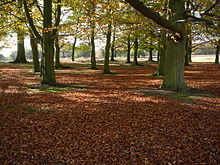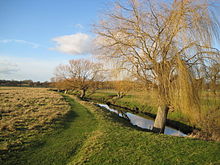
Back ريتشموند بارك Arabic Richmond Park Catalan Richmond Park (parke sa Hiniusang Gingharian) CEB Richmond Park Czech Richmond Park Danish Richmond Park German Πάρκο του Ρίτσμοντ Greek Parque de Richmond Spanish Richmond parkea Basque پارک ریچموند Persian
| Site of Special Scientific Interest | |
 Isabella Plantation, Richmond Park | |
| Location | Greater London, England, United Kingdom |
|---|---|
| Grid reference | TQ2073 |
| Interest | Biological, historical |
| Area | 2360 acres (955 hectares)[1] |
| Notification | 1992 |
| Location map | Magic Map |
Richmond Park, in the London Borough of Richmond upon Thames, is the largest of London's Royal Parks and is of national and international importance for wildlife conservation. It was created by Charles I in the 17th century[2] as a deer park. It is now a national nature reserve, a Site of Special Scientific Interest and a Special Area of Conservation and is included, at Grade I, on Historic England's Register of Historic Parks and Gardens of special historic interest in England. Its landscapes have inspired many famous artists and it has been a location for several films and TV series.




Richmond Park includes many buildings of architectural or historic interest. The Grade I-listed White Lodge was formerly a royal residence and is now home to the Royal Ballet School. The park's boundary walls and ten other buildings are listed at Grade II, including Pembroke Lodge, the home of 19th-century British Prime Minister Lord John Russell and his grandson, the philosopher Bertrand Russell. In 2020, Historic England also listed two other features in the park – King Henry's Mound which is possibly a round barrow[3] and another (unnamed) mound which could be a long barrow.[4][5][6]
Historically the preserve of the monarch, the park is now open for all to use and includes a golf course and other facilities for sport and recreation. It played an important role in both world wars and in the 1948 and 2012 Summer Olympics.
- ^ Cite error: The named reference
Hansardwas invoked but never defined (see the help page). - ^ Historic England (2015). "Richmond Park (397979)". Research records (formerly PastScape). Retrieved 3 May 2015.
- ^ Historic England (27 May 2020). "King Henry VIII's Mound, Richmond Park (1457267)". National Heritage List for England. Retrieved 8 June 2020.
- ^ Historic England (16 March 2020). "Mound at TQ1891972117, Richmond Park (1457269)". National Heritage List for England. Retrieved 8 June 2020.
- ^ "Ancient Burial Mounds in London's Richmond Park Protected" (Press release). Historic England. 31 May 2020. Retrieved 8 June 2020.
- ^ "King Henry VIII's Mound protected as scheduled monument". BBC News. 1 June 2020. Retrieved 8 June 2020.